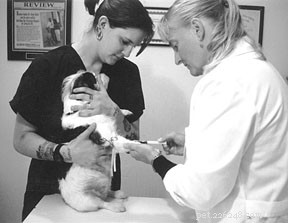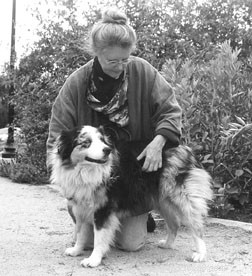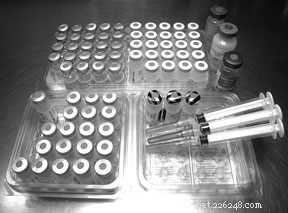
– Podpořte imunitní systém svého psa čerstvým krmivem, dostatečným (ne nutně namáhavým) cvičením, denním světlem a láskyplnou, praktickou pozorností.
– Nepřeočkovávejte! Pomocí testů titru zjistěte, zda imunitní „paměť“ vašeho psa potřebuje „posílení“.
– berte chronické zdravotní problémy vašeho psa jako znamení, že musíte podniknout další kroky k vyvážení jeho imunitního systému; doplňkové terapie jsou v tomto ohledu vynikající.
Imunitní systém je "velkým ochráncem" psa. Být imunní (z latinského immunis , znamená zdarma nebo osvobozený) je třeba chránit před infekčními chorobami buď specifickými nebo nespecifickými mechanismy.
Úkolem velkého ochránce je reagovat na infekční výzvy a antigenní podněty z vnějšího světa a vhodně na ně reagovat. Vhodná imunitní reakce vytvoří obranu proti vyzyvatelům těla, aniž by následně zničila samotného hostitelského zvířete; tento typ reakce předpokládá, že imunitní systém dokáže rozpoznat nebo odlišit své „já“ od vetřelce, „nejá“.

Studie imunitního systému zahrnují jeho základní strukturu a funkci spolu se všemi biologickými, sérologickými, fyzikálními a chemickými aspekty imunitních jevů. Kromě toho se imunitní funkce účastní imunizace (vakcíny), transplantací orgánů a krevních transfuzí.
Funkční testování imunitního systému může zahrnovat laboratorní testy buněčných a humorálních (týkajících se „humorů“ nebo tělesných tekutin, zejména zahrnujících krev) složek imunologie a použití reakcí antigen-protilátka (sérologie a imunochemie). . K indikaci aktuálního stavu imunitního systému zvířete lze použít snadno proveditelné klinické patologické testy (například CBC nebo biopsie jehlou).
Fyzická část imunitního systému psa sahá od subcelulární úrovně až po celý organismus. Každá buňka a všechny orgánové systémy mají své vlastní složky imunity a každá má zase nějaký nezávislý, vnitřní regulátor. Nedávné důkazy naznačují, že emoce zvířat mají hluboký vliv – někdy pozitivní, někdy negativní – na imunitu zvířete. A dokonce i faktory prostředí, jako je hluk, pachy, světelné vzory a/nebo látky znečišťující životní prostředí, mohou mít vliv na biochemii a buněčné složky imunitního systému.
Imunitní systém byl rozsáhle studován redukčním modelem západní vědy. Z pohledu holistického praktika je však nejdůležitějším aspektem systému jako celku, že každá jednotlivá složka imunity je úzce propojena. Prostřednictvím těchto spojení jsou všechny mikroskopické části systému v neustálé a intimní komunikaci se všemi ostatními částmi.
Právě tato vnitřní komunikace se stává důležitou při zaujímání holistického přístupu ke zdraví psa. Zatímco západní medicína se obvykle soustředí na konfrontaci s jednou složkou nemoci, holistická medicína se snaží začlenit všechny aspekty té velké ochranné vnitřní sítě a vnější přikrývky, kterou je imunitní systém, a nakonec se je všechny snaží uvést zpět do rovnováhy. „Rovnováha“ je zde operativní slovo – nerovnováha v obou směrech, buď hypoaktivní nebo hyperaktivní imunitní systém, nakonec povede k onemocnění.
Nejznámějšími složkami imunitního systému jsou ty, které se nacházejí v krevním a lymfatickém systému – oběhový imunitní systém. Lymfocyty a imunoglobuliny bývají mediálními miláčky imunitního systému. Mnoho lékařů krátkodobě upouští od jiných, stejně důležitých složek, jako je kůže a další tělesné bariéry, slizniční výstelky mnoha tělesných povrchů, gastrointestinální trakt, plíce, hormonální vstup do systému a propojený imuno-komunikační systém.
Tradičně se cirkulující imunitní systém dělí na dvě složky:buněčnou (primárně lymfocyty) a humorální (komplexní proteiny, které se označují jako imunoglobuliny nebo protilátky).
Buněčné složky tohoto oběhového systému zahrnují dva typy lymfocytárních buněk:B-buňky a T-buňky. Jedním z účelů populace lymfocytů je rozpoznávat antigeny. Antigen je jakákoliv látka, která je schopna vyvolat imunitní odpověď; bakterie, viry a paraziti jsou antigeny.
Poté, co lymfocyty rozeznají látku jako „nevlastní“ a „nedobrou pro sebe“, mohou vstoupit přímo do procesu ničení a odstraňování cizího vetřelce. Nebo mohou prostřednictvím produkce protilátek (imunoglobulinů) aktivovat další buňky – včetně bílých krvinek, neutrofilů, eozinofilů a monocytů – které za ně dělají špinavou práci. Celkový počet bílých krvinek a poměr druhů bílých krvinek pozorovaných ve vzorku (pozorovaný na CBC nebo kompletním krevním obraze) mohou být užitečné při určování typu přítomného onemocnění (viz „Jak využít další krevní test vašeho psa, “listopad 2003).
Existuje několik tříd T-lymfocytů:pomocné buňky, cytotoxické buňky a supresorové buňky. Každá třída působí svým vlastním způsobem jako koordinátor a/nebo stimulátor imunitního systému. Kromě působení na cirkulující bílé krvinky ovlivňují T-buňky také lymfatické uzliny, brzlík, slezinu, střeva, mandle, normální flóru štěnic „dobráků“, které se vyskytují v různých oblastech těla a slizniční ochranný povlak, který vystýlá mnoho tkání.
B-lymfocyty jsou paměťové buňky imunitního systému a jsou to buňky primárně zodpovědné za humorální imunitu. B-buňky produkují proteiny nazývané imunoglobuliny, které působí jako protilátky, a tyto protilátky interagují s antigeny, které byly zavedeny do těla. Tato interakce typicky tvoří proteinový komplex, který lze z těla odstranit.
Existuje několik tříd imunoglobulinů:IgA, IgE, IgG, IgM a IgD. Imunoglobuliny se nacházejí v gamaglobulinové části krevního séra. Každá třída imunoglobulinů má typickou oblast těla, kde se nejčastěji vyskytuje; každý z nich má specifické antigeny, se kterými interaguje, a každý má svůj vlastní způsob výroby odstranitelného komplexu antigen/protilátka.
Například IgE aktivuje okamžité hypersenzitivní reakce a IgA se obecně podílí na imunitních funkcích sekrečních orgánů. IgG je jediná třída přenášená přes placentu a je zodpovědná za mateřské protilátky, které chrání štěňata několik týdnů po narození.
K určení třídy a relativního množství přítomného imunoglobulinu se používají specifické testy. I když jsou tyto testy obecně nespecifické, mohou poskytnout určitou indikaci typu probíhajícího procesu onemocnění.
B-buňky jsou dlouhověké, možná tak dlouho, jako je celá délka života zvířete. Když jsou B-buňky vystaveny antigenům po celý svůj život, ukládají si paměť na tyto antigenní expozice, aby proti nim mohly reagovat, až budou později vystaveny.
Vakcíny se spoléhají na stimulaci B-buněk, takže budou kódovány pamětí specifického antigenu nalezeného ve vakcíně. Myšlenka vakcinačních antigenů je poskytnout tuto paměť antigenu, aniž by způsobila onemocnění (doufáme!); tato vzpomínka pak (opět doufáme!) stimuluje vhodnou reakci na skutečnou expozici antigenu později.
V závislosti na zdravotním stavu jedince tvoří lymfocyty asi 20 až 40 procent nebo více buněk v krvi a mají také svůj vlastní způsob cirkulace v těle:lymfatický systém. Na rozdíl od krve, která je pumpována do celého těla srdcem, nemá lymfatický systém žádnou aktivní pumpu, a proto se musí spoléhat na svalovou aktivitu, aby přesunul své tekutiny bohaté na lymfocyty z jedné oblasti těla do druhé.
Lymfatické uzliny se vyskytují na různých místech lymfatického oběhu těla. Jsou to akumulace lymfocytů a dalších buněk včetně makrofágů (doslova velcí jedlíci), buněk, které zabíjejí, jedí, zpracovávají a eliminují cizí látky.
U zdravých zvířat se lymfa pohybuje jako plynulá řeka, přenáší imunitní informace z jedné části těla do druhé, přivádí aktivované lymfocyty do oblastí, kde jsou potřeba, a pomáhá odstraňovat nahromaděné zbytky a toxiny. Lymfa proudí do oblasti zánětu a přispívá k otoku, který se tam vyskytuje. Tekutá lymfa se také může hromadit a přispívat k edému, kdykoli je zvíře (nebo normálně se pohybující část zvířete) neaktivní po libovolně dlouhou dobu a může dojít ke znatelnému otoku.
Dokonce i u zdravého zvířete jsou některé lymfatické uzliny dostatečně velké na to, aby je bylo možné palpací lokalizovat v určitých oblastech (zejména podél krku a zadních končetin), ale mohou se také zvětšit do velmi viditelných hrudek, když aktivně drénují infikovanou oblast nebo když jsou postiženy nádory – např. lymfosarkom nebo jiné nádory, které metastázovaly do regionálních lymfatických uzlin. Jednoduché biopsie jehlou mohou být užitečné při určování příčiny zvětšení lymfatických uzlin.
Kromě pohyblivé (lymfatické) a stacionární (lymfatické uzliny) sítě lymfatického systému jsou lymfocyty výraznou součástí dalších částí těla. Ve skutečnosti se největší akumulace lymfoidní tkáně v těle nachází ve střevě (více o tom níže).
Nové děti na bloku imunitního systému jsou dendritické buňky. Dendritické (větvené jako strom) buňky je obtížné izolovat, takže jejich studium je v plenkách, ale může se ukázat, že jsou jednou z nejdůležitějších složek imunitního systému.
Dendritické buňky jsou obecně umístěny tam, kde dochází k maximálnímu mikrobiálnímu setkání – kůže, střevo a plíce. Lze je považovat za buňky lokálního dohledu, které fungují jako most mezi vrozenou a získanou imunitou tím, že spouští specifické buněčné a humorální imunitní reakce.
Dendritické buňky používají své větvící se „končetiny“ k tomu, aby cítily místní prostředí pro vnikající antigeny. Fyzicky přenášejí tuto antigenní informaci do lokálních lymfatických uzlin pro zpracování a následnou aktivaci lymfoidního imunitního systému celého těla. Dendritické buňky a lymfoidní systém tak interagují a vytvářejí spletitou síť komunikace z místně exponovaných buněk směrem ven do vzdálených částí těla.
Dendritické buňky si zachovaly mnoho receptorů pro rozpoznávání vzorů starověkého imunitního systému a mají jedinečnou schopnost vnímat stimulace, jako je poškození tkáně a nekróza, stejně jako bakteriální a virové infekce. Tyto receptory pro rozpoznávání vzorů jsou zakódovány v zárodečné linii každého zvířete a předávají se z generace na generaci – možná jeden z důvodů, proč se zdá, že linie chovu psů dědí imunitní schopnosti svých rodičů, ať už dobré nebo špatné.
Kromě krevního a lymfatického systému se na funkci imunitního systému tak či onak podílejí všechny orgánové systémy a všechny jsou rovněž ovlivněny – pozitivně či negativně – schopností (či neschopností) zvířete vhodnou imunitní reakci. Existují však některé orgánové systémy, které jsou v imunitní odpovědi obzvláště převládající.
• Normální flóra. Normální, zdravé zvíře se brouky doslova hemží. Říká se, že na zdravém zvířeti a v něm je mnohonásobně více brouků, než je celkový počet buněk, které má zvíře v celém těle.

Například každý čtvereční centimetr zdravé (lidské) kůže obsahuje 10 000 až 100 000 brouků! And, depending on where the sample is collected, a persistent bug counter will find anywhere from 100,000 to 1,000,000,000,000 bugs in each gram of intestinal contents. These good-guy bacteria produce many biochemicals that destroy other, pathogenic bacteria.
• Skin. Everyone knows that a dog’s skin, the largest organ of his body, acts as a physical barrier. But is also contains intrinsic factors that enhance his overall immunity. We’ve already seen that skin is replete with good-guy bugs. In addition, hair follicles produce sebum, an oily substance that contains lactic acid and fatty acids, both of which inhibit growth of some pathogenic bacteria and fungi.
Too-frequent bathing or persistent use of antibiotic-type soaps can destroy the natural immune function of the skin by drying it (opening pores and minute skin cracks to invasion of bacteria), eliminating beneficial bugs, and removing the protective layers of oils and acids.
• Mucosal barriers. The inner linings of several organs – the gastrointestinal tract, lungs, urethra, and urinary bladder, as examples – are lined with a thick and tenacious layer of mucus that traps (and may kill) foreign bodies, including microorganisms.
• Gastrointestinal tract. From its beginning to its endpoint, the gastrointestinal tract is actively involved in the animal’s immune functions. Lysozymes in the saliva (and also occurring in healthy tears) can break down the walls of some bacteria. The normally acidic environment of the stomach is an effective barrier to many incoming germs. The lining of the intestinal tract is also coated with mucus, another effective way to prevent the invasion of microorganisms.
As discussed above, an extremely important component of the gut’s immune function is the presence of the normal flora, the naturally occurring bugs of the gut.
Finally, the gut is a prime source of lymphocytes, containing more of these immune cells than any other part of the body. This accumulation of lymph cells is collectively called GALT, for “gut associated lymphoid tissue.” GALT begins with the lymphoid tonsils in the throat and is further expressed by large patches of lymphoid tissues, called Peyer’s patches, that are located along many areas of the intestinal tract. The job of GALT is to recognize incoming foreign particles that may be harmful.
• Lungs. The innate and first line of defense of the lungs includes the germ-trapping mucosal lining of the inner lung walls along with tiny hairs whose ciliary action, along with sneezing and coughing, ejects living and nonliving things. Dendritic cells are also an active component of the lung’s immune system, along with a healthy population of white blood cells and immunoactive cells in the epithelial lining.
It is interesting to note that some of the immune pathways of the lungs are activated by mechanical stretching, further adding to the notion that exercise is healthy for the immune system.
• Liver. The liver is another prime site for immune function, and it is healthily supplied with lymphoid tissues as well as liver macrophages (Kupffer’s cells).
The liver is also a prime organ for processing and eliminating all sorts of toxins, and its antitoxic abilities are crucial for the health of the animal’s immune system. In light of this, it is interesting to note that the most common cause for withdrawal of drugs from the human pharmaceutical market is drug-induced liver injury (often referred to as DILI).
Drugs can be either directly toxic to liver cells, or they can adversely affect the liver’s immune function. This latter reaction may not show up until days or weeks after the beginning of drug use, and it is easy to miss the connection. According to one report, in humans DILI accounts for more than 50 percent of acute liver failure!
• Hormones. Many, if not all, of the hormones of the body have either a direct or indirect effect on the immune system. Of particular interest are the thyroid and sex hormones.
Many practitioners feel that the thyroid is the master gland of the body. The thyroid can also be easily affected by outside influences – one of interest to holistic practitioners is that vaccines and/or the preservatives in vaccines have been linked to thyroid dysfunction.
The overall capability of the immune system may also be adversely affected by sex hormones, and particularly the female sex hormones. Autoimmune problems such as diabetes, lupus, hypothyroid, and rheumatoid arthritis are much more common in females than males.
There are several ways normal immune function can be disrupted or inhibited. The following are some of the most common.
Many diseases, especially those caused by viruses, can directly attack the cells of the immune system. Or they can be more insidious and slowly infiltrate one or more components of the immune system and ultimately cause diminished effectiveness.
Stress, especially if it is prolonged and if the animal can’t avoid it, can eventually overwhelm the ability of the immune system to respond, ultimately leading to increased susceptibility to disease. However, some stress is good for the body and soul, rather like working the immune-muscles to make them stronger.
An interesting study recently demonstrated that short-term moderate stress to animals (two hours of restraint) enhanced the immune response of the skin. This response was measured to be two to four times more robust than a normal response, it occurred quicker than normal, and it remained strong for weeks to months after the stress had ended.
“We believe that in many situations of acute stress, the body prepares the immune system for challenges such as wounds or infections,” says Firdaus Dhabhar, one of the study’s coauthors. “The immune system may respond to warning signals (such as stress hormones) that the brain sends out during stress. These prepare the body to deal with the consequences of stress.”
While antibiotics can help the immune system by decreasing the numbers of pathogenic bacteria, they can also destroy much of the animal’s protective mechanisms by killing the good-guy bugs that normally inhabit the gut, the skin, and other parts of the body.
Corticosteroids may be used to inhibit a hyperactive immune process, but excessive or prolonged use may inhibit the system to the point that it is no longer functional.
Vaccines are meant to stimulate the immune system so that it will be able to mount a later attack against the specific disease the vaccine is directed against. Problems with vaccines occur when the immune stimulation is too much for the animal to handle. This may cause anaphylaxis – a rare but immediate hypersensitive reaction that can be life-threatening.
More commonly (at least in the minds of holistic practitioners), the repeated introduction of vaccine antigens, along with the presence of modified viruses shed into the environment, may provide the final insult that exceeds the immunological tolerance threshold of some individuals. These individuals may exhibit any number of immune-related diseases, including arthritis, inflammatory bowel disease, cystitis, and skin conditions.
Most holistic practitioners (including me) feel that nearly all diseases have a direct link to an imbalance of the immune system, and those that aren’t directly involved eventually have an adverse effect on the system. There are some diseases that are known for their involvement with the immune system, and these can be loosely divided into those where the system is hyperactive or where it is hypoactive.
Anaphylaxis is the term used to describe any acute, systemic manifestation of the hyperactive interaction of an antigen as it binds to an antibody. (This is also termed a Type I reaction, and it is typically the result of IgG immunoglobulins triggering a reaction with mast cells and basophils.) Possible causes include stinging and biting insects, vaccines, drugs of any kind, food substances, and blood products (transfusion from an improperly matched blood type, for example).
Clinical signs of anaphylaxis include restlessness and excitement, itch, edema, salivation, tearing, vomiting, abdominal pain, diarrhea, difficult breathing, shock, convulsions, collapse, and possibly death. Unlike other animals that typically have severe respiratory signs, the organ that is primarily affected in the dog is the liver; gastrointestinal signs rather than respiratory signs are more apt to be seen in dogs.
Anaphylactic shock and total collapse can be the result. Or more focal reactions may occur, including hives, itching, and facial swelling, especially around the eyes. Other diseases considered to be anaphylactic or Type I reactions include allergic rhinitis, chronic allergic bronchitis, allergic asthma (less common in animals than in man), food allergies, and atopic dermatitis, a chronic itchy skin disorder.
Other immune-related diseases are related to the self-production of antibodies that are toxic to various cells within the animal’s own body – a classic case of the immune system not being able to recognize “self.” The inciting agent for the self-against-self reaction is not always evident, but often appears to be related to drugs or to an oversupply of antigens from outside sources (vaccines).
The most common diseases in this category (also termed Type II reactions) include the complex of autoimmune hemolytic anemia (AIHA) and autoimmune thrombocytopenia. In general, autoimmune skin disorders fall into the various “pemphigoid” conditions.
Myasthenia gravis is a rare disease that causes extreme muscular weakness. Its symptoms are the result of autoantibodies that are directed against receptors that energize muscle activity.
Another way the immune system can run amok is by producing immune antigen/antibody complexes that are deposited in various areas of the body. These complexes interfere with normal function, and symptoms depend on the area affected. Examples of these (Type III) reactions include canine rheumatoid arthritis, systemic lupus erythematosus (SLE), and glomerulonephritis (a kidney disease).
A final category of hyperactive immune diseases (Type IV reactions) activates the cell-mediated portion of immunity. Diseases in this category include contact sensitivity, autoimmune thyroiditis, and keratitis sicca.
At the other end of the spectrum, the hypoactive immune system, there are several diseases that result in poor immune performance. The most common of these result from infection with various viruses – for example, canine distemper, parvovirus infections in dogs and cats, and AIDS in humans.
Maintaining immune health is a matter of trying to keep the whole of the system in balance with itself as well as in balance with the animal as a whole. Following are some general (and user-friendly) ways to help balance the immune system:
• Massage and exercise. The easiest and most enjoyable way to enhance your dog’s immune system is to put your hands to fur. Massage has been proven to increase lymphocyte numbers and to enhance lymphocyte function. The relaxation that comes with a good massage is good for emotional health, which has also been proven to be good for the immune system. The best part of massage is that it benefits the giver as well as the receiver; you enhance your own immune system as you help your best buddy enhance his or hers.
Exercise is another easy-to-implement activity that has proven, direct benefits for the immune system. In addition, the muscle activity helps cleanse the body of toxins and helps to move important components of immunity from one part of the body to another.

You don’t have to be overstructured about massage or exercise. Simply rub your best buddy in a way you’d like to be rubbed, and take a daily walk or romp in the park.
• Nutrition. The immune system demands good nutrition. Conversely, a diet deficit in any of the necessary nutrients will almost certainly cause immune-related disease. Specific nutrients that are indicated for immune-system health include:vitamins A (beta-carotene), C, E, and B-6; zinc; selenium; linoleic acid; and lutein.
Many of the above nutrients are high in antioxidant activity, and this may be the reason they are immune-supportive. Herbs and unprocessed vegetables are also excellent sources of antioxidant activity. It is interesting to note that recent studies have shown that the effects of antioxidants is much more profound when they come from a natural source rather than in the form of a pill or capsule.
• Byliny. Some herbs demonstrate a direct immune-enhancing activity. In most cases this enhancement actually balances immune function rather than being purely stimulating. For example, when given as the ground-up parts of the entire (fresh or dried) plant, echinacea has been shown to increase lymphocyte numbers when they are abnormally low, thanks to one of several biochemicals it contains. The same plant contains another biochemical that actually decreases the lymphocytes when their numbers are abnormally high.
Many herbs, ounce for ounce, have as much or more antioxidant activity than that found in vitamins A, C, and E. Herbs can be given on a daily basis, in the form of a pinch of fresh or dried herb sprinkled over your dog’s food or a mild tea made from the herb and poured over his food.
• Alternative medicines. Acupuncture is said to enhance the flow of chi, that immeasurable energy that flows throughout the body. It is thus a balancing medicine, and as it balances all parts of the body, it likewise helps to balance and enhance immune function.
Homeopathy works by enhancing what homeopaths refer to as the vital force, again by helping to balance this immeasurable vital force throughout the body. Many homeopaths equate the vital force to the immune system; its actions are similar, if not the same, as an intact and healthy immune system.
Flower essences and aromatherapy have been shown to enhance an animal’s immune function. It is likely these two work by modulating emotions which in turn enables the mind/body connection to ease the immune system into more optimal performance.
Dr. Randy Kidd získal titul DVM na Ohio State University a doktorát v oboru patologie/klinická patologie na Kansas State University. Bývalý prezident American Holistic Veterinary Medical Association, je autorem Dr. Kidd’s Guide to Herbal Dog Care and Dr. Kidd’s Guide toHerbal Cat Care.

Obhajovat znamená podporovat nebo prosazovat zájmy druhého. Jako trenér vždy povzbuzuji své klienty, aby byli obhájci svých psů. Pro mě to znamená dát přednost fyzické a emocionální pohodě vašeho psa před vašimi vlastními potřebami. To zahrnuje ochranu vašeho psa před zraněním, před jinými psy a jin

S více než rokem sociálního distancování za námi se mnozí z nás touží vrátit k socializaci s blízkými. Vzrušení ze socializace může také přijít s určitou úzkostí – pamatujeme si vůbec, jak být společenský? Pamatují si naši psi své sociální dovednosti? Nestihla naše pandemická štěňata své socializačn